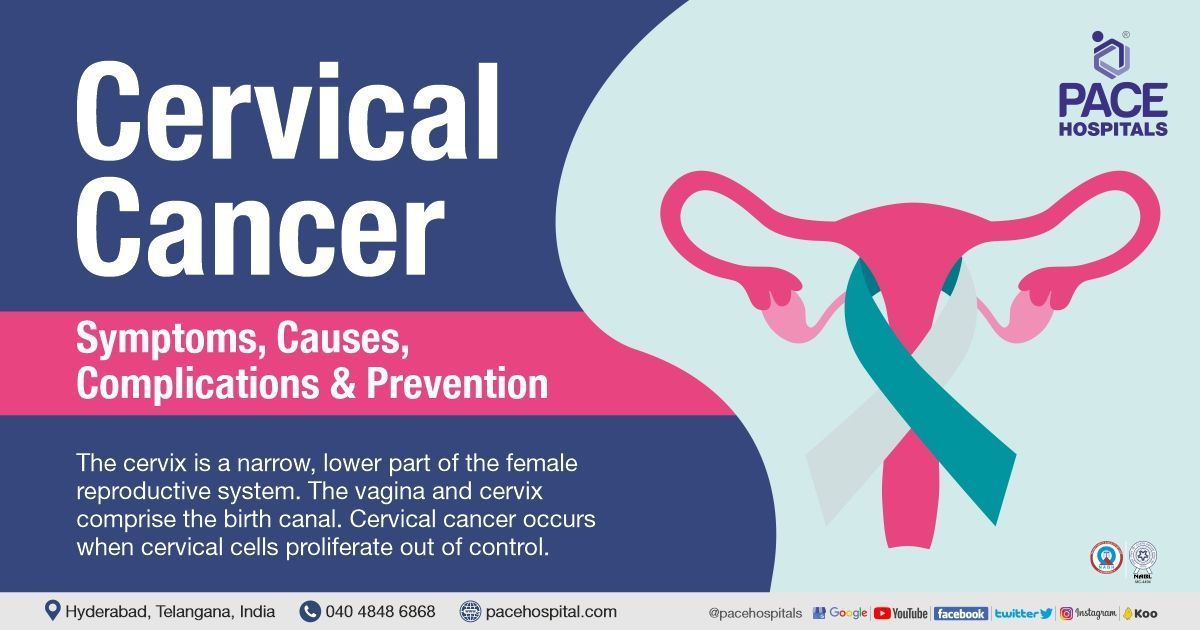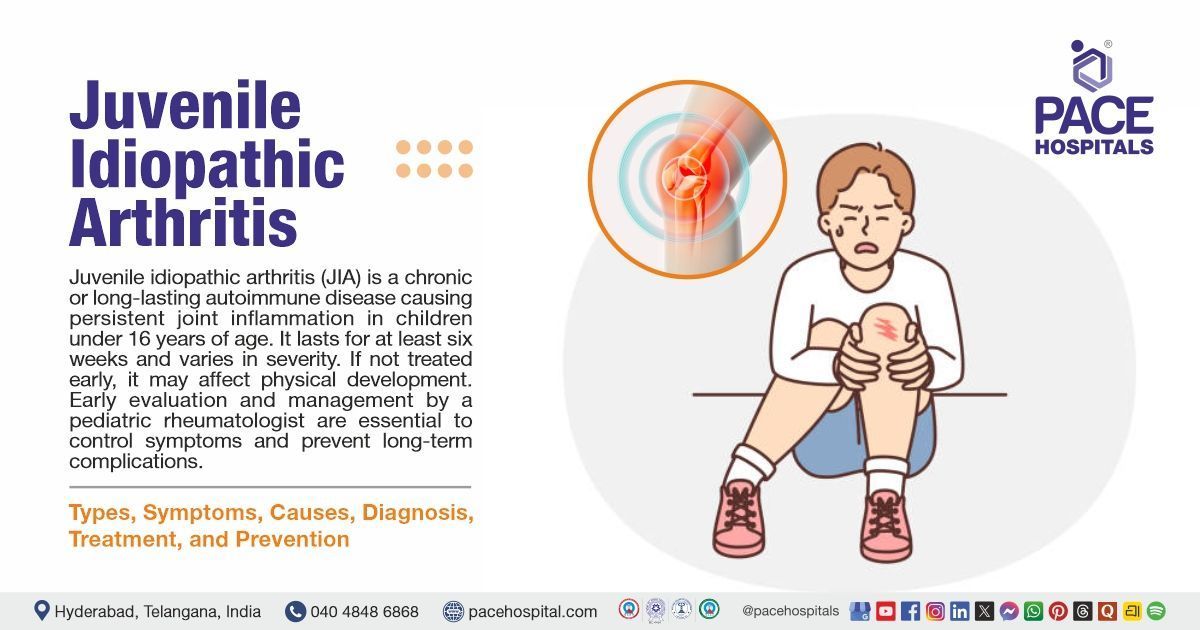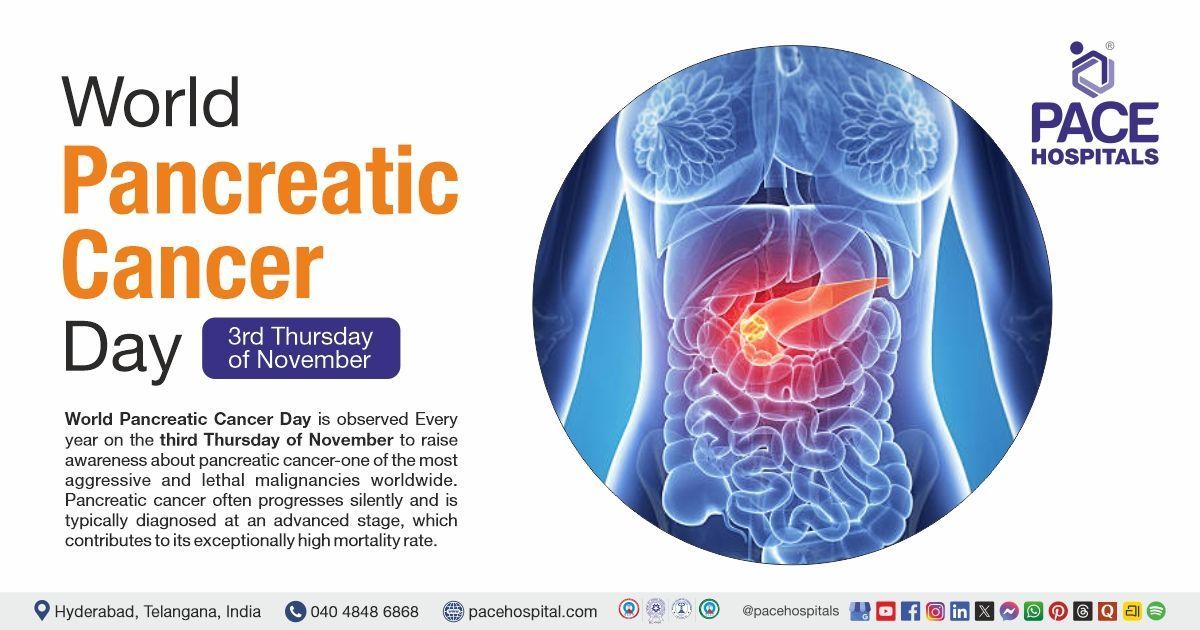Cervical Cancer - Symptoms, Causes, Types, Risk Factors
PACE Hospitals
Overview of cervical cancer
Cervical cancer meaning
Cancer develops when normally functioning cells undergo mutation and multiply out of control, forming a tumour mass that can happen in any tissue. When cervical cells proliferate (increase rapidly in number or multiply) out of control, it is called cervical cancer.
The cervix is a narrow and lower part of the female reproductive system. Uterus holds the foetus during pregnancy. The vagina and cervix comprise the birth canal.
The role of the cervix in a healthy woman is principally concerned with reproduction – ithelps to keep the developing foetus in the uterus. It has a part to play in the initiationand progression of labour. The mucus produced by the cervix is vital for female fertility.
Long-term infection of human papillomavirus (HPV) on the cervix can result in cancer, leading to a mass or tumour on the cervix. Both benign (non-cancerous) and malignant (cancerous) forms of tumours exist. A malignant tumour may quickly develop and metastasize (spread) to other organs if left untreated. When a tumour is considered benign, it might still grow but will not metastasize.
Cervical Cancer Prevalence
Cervical cancer in India is the 2nd most prevalent cancer.
An Indian paper published in 2020 showed that according to statistics, around 5,27,624 new cases of cervical cancer are diagnosed each year globally, of which Indians contribute around 1,22,844 cases.
- Women in India have accounted for approximately one-third of worldwide cervical cancer mortality with…
- A 1.6% risk of acquiring cervical cancer and
- A 1% risk of dying from the same.
A Lancet study from 2020 showed a steep decline in cervical cancer prevalence in India and other countries, such as Thailand, Brazil, and Poland.
This could be attributed to multiple factors, such as declined fertility rates across successive generations of women or improved coverage of screening facilities with broad access to cervical cancer treatment services, particularly in the urban population.
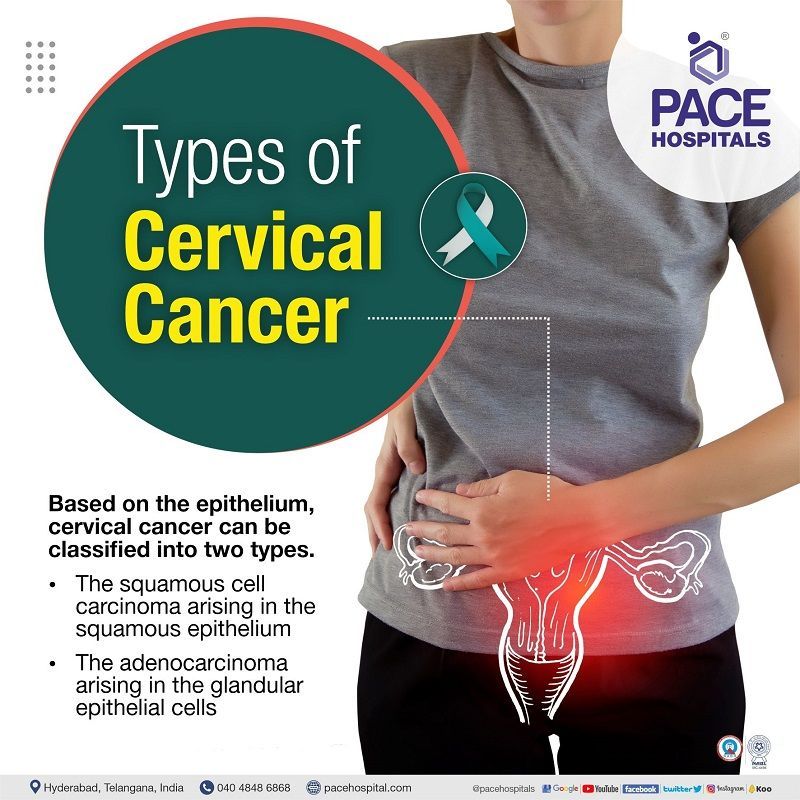
Types of Cervical Cancer
The anatomy of the cervix is subdivided into the endocervix and the exocervixor ectocervix. The ecto and endocervix are lined with two different types of the epithelium (layer) – the endocervix with columnar glandular epithelium and the ectocervix with squamous epithelium.
There are mainly two types of cervical cancer. They are:
- The squamous cell carcinoma
- The adenocarcinoma
The most common is squamous cell carcinoma involving the squamous epithelium lining the ectocervix.
However, 20% of cervical cancers are adenocarcinomas involving the glandular epithelial cells.
A small percentage of cervical cancers are also composed of rare histological types such as lymphomas, sarcomas andneuroendocrine tumours.
Cervical Cancer Causes
Cervical neoplasia is a disease for which the principal causative agent has been clearly identified. Whilst several other factors will influence the progression and development of the disease, the key to cervical neoplasia and cervical cancer is HPV (Human Papilloma Virus).
Evidence indicating a role for HPV in cervical cancer is now so strong that the International Agency for Research on Cancer (IARC) and the World Health Organisation (WHO) have officially acknowledged high-risk HPV as a known human carcinogen.
HPV is also associated with several other cancers, such as oral, vulval, vaginal, penile and anal.
However, infection with HPV does not inevitably mean cervical cellular abnormality will develop. There is ongoing research about why few women infected with HPV are asymptomatic, without experiencing any cervical cellular change, whereas others develop cervical intraepithelial neoplasia and invasive cancer.
Cervical Cancer Symptoms
The following are the symptoms of cervical cancer that usually presented, however not all the symptoms need to be presented during cervical cancer diagnosis or physical investigation
- Menorrhagia (menstrual bleeding that is thicker and lasts longer than usual)
- Unknown cause of recurrent pelvic and/or back discomfort
- Blood splotches or mild bleeding between or after periods
- Postcoital bleeding (bleeding following sexual activity)
- Bleeding during douching (spray or shower with water)
- Dyspareunia (pain during a sexual encounter)
- Bleeding during a pelvic examination
- Bleeding during menopause
- High vaginal discharge
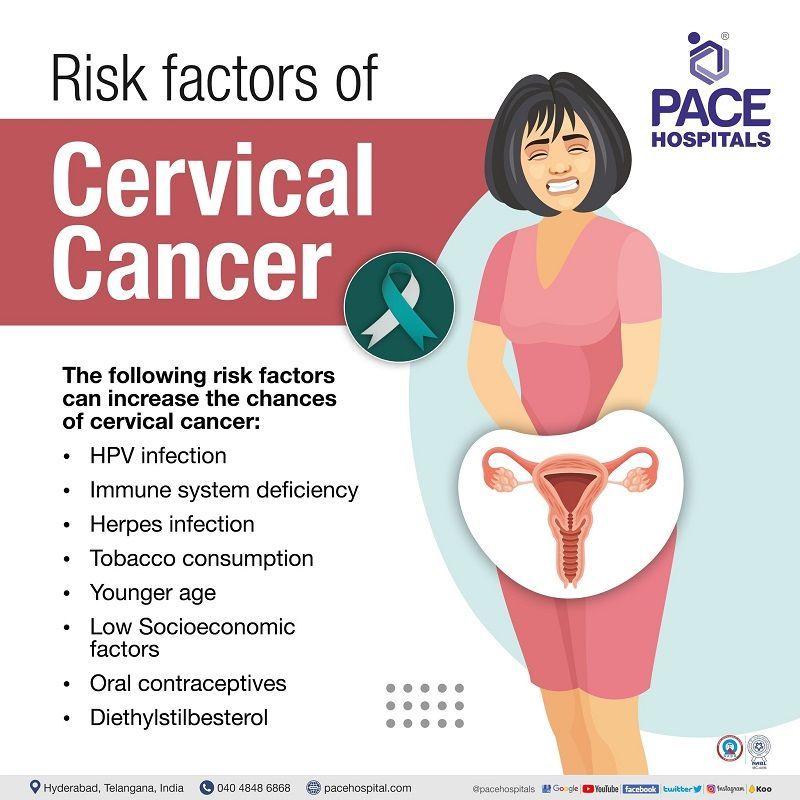
Cervical Cancer Risk Factors
Even though cervical cancer is often linked to risk factors, most risk factors do not directly cause it. There are documented cases of cancer development without exposure to any risk factors, while others remain despite heavy indulgence in risk factors.
The following factors may amplify the risk of developing cervical cancer:
- HPV infection: HPV is the most significant cervical cancer risk factors, but most people recover from the illness following sexual activity. Approximately 100 kinds of HPV are seen; not all are cancer-related. HPV16 and HPV18 cause cervical cancer most often. Early sex or multiple sexual partners increase the chance of high-risk HPV infection. HPV immunizations prevent cervical cancer. HPV-related cancer information.
- Immune system deficiency: Weaker immune systems are more likely to contract cervical cancer. Immune suppression can be caused by corticosteroid drugs, organ transplants, treatments for other types of cancer, or the human immunodeficiency virus (HIV), which causes acquired immune deficiency syndrome (AIDS). When a person has HIV, their immune system can't fight off early cancer as well as it could.
- Herpes: A sexually transmitted disease, herpes can cause contagious sores, most often around the mouth or on the genitals. People suffering from genital herpes pose a higher risk of developing cervical cancer.
- Tobacco consumption: People who consume tobacco are almost twice more at risk for developing cervical cancer.
- Age: Cervix cancer is rarer in people younger than 20 compared to the late teens and mid-30s, as the risk increases in this period. People older than this age group could still get cervical cancer, which is why regular screenings, such as a Pap test and/or an HPV test, must be done.
- Socioeconomic factors: Cervical cancer is more frequent among people from low-income households, who are less likely to have access to cervical cancer screening.
- Oral contraceptives: Research demonstrated that oral contraceptives, or birth control tablets, may be linked to an increased risk of cervical cancer and higher-risk sexual activity. Studies are still underway in understanding the relationship between oral contraceptive usage and the development of cervical cancer.
- Diethylstilbestrol (DES): A rare type of vaginal or cervical cancer is seen in patients whose mothers have taken DES during their pregnancy. This drug is indicated to avoid miscarriage.
Complications of Cervical Cancer
Cervical cancer treatment includes the treatment of cervical cancer and its complications. The primary difficulties encountered are pain, vaginal bleeding, rectovaginal and vesicovaginal fistulas, uraemia.
Pain: A significant problem which is produced due to the
- compression and destruction of nerves,
- invasion of contiguous pain-sensitive structures,
- infiltration and occlusion of arteries, veins and lymphatics,
- infection and inflammation,
- obstruction of hollow viscera
Profound vaginal haemorrhage: Bleeding is a common complication in individuals with advanced cervical cancer. Cancer can produce bleeding as a result of local tumour invasion, aberrant tumour vasculature, or tumour regression. These episodes can range from little leakage to significant episodic bleeding or even catastrophic haemorrhage.
Vaginal haemorrhage may occur sporadically and produce severe anaemia, or even death must be prevented.
Malodorous vaginal discharge: A source of discomfort and a cause for neglect on the part of friends and relatives, which is why aesthetic well-being is also vital. One of the patients' most common main complaints is thatthe cause of vaginal discharge must be understood. Usually, the oncologist may prescribe a colposcopy and pathological biopsy.
Uraemia and/or pyelonephritis: Uraemia (high levels of urea in the blood) and/or pyelonephritis (kidney inflammation due to infection) may cause death.
Since the ureter passes just lateral to the cervix in its course to the bladder, invading cancer gradually compresses it, producing hydronephrosis (kidney swelling due to urine build-up) with ensuing uraemia and pyelonephritis. Even fibrosis from irradiation or surgical intervention could cause urethral constriction resulting in hydronephrosis.
Vesicovaginal fistula (abnormal opening between the vagina & bladder results in urinary incontinence): High rates of vesicovaginal fistula formation can be expected when treating women with the extension of cervical cancer into the bladder or rectum, particularly among women who smoke. It is more familiar with the progression of cancer - Stage IVA cervical carcinoma.
In conjunction with vesicovaginal fistulas, the rectum is often invaded and breaks down (rectovaginal fistula), discharging the faecal stream into the vagina. If their life expectancy is of any length, such patients deserve operative repair.
Why Choose PACE Hospitals?
Expert Super Specialist Doctors
Advanced Diagnostics & Treatment
Affordable & Transparent Care
24x7 Emergency & ICU Support
Cervical Cancer Prevention
Pap smear tests and HPV testing can detect pre cancers and treat them to avoid cervical cancer. The Papanicolaou test (Pap smear for short) is a cervical screening technique used to find possibly malignant or precancerous processes in the colon or cervix. HPV vaccination, also called the cervical cancer vaccine, prevents HPV infection, thus preventing cancer altogether.
The U.S. Food and Drug Administration (FDA) approved the HPV vaccine to prevent cervical cancer caused by HPV in persons aged 9–45 years.
Cervical cancer vaccine India (CERVAVAC)
Currently, India is developing an indigenous cervical cancer vaccine – CERVAVAC, which is expected to roll out sometime by mid-2023. CERVAVAC has already received approval from the office of the Drug Controller General of India (DCGI).
When it comes to cervical cancer prevention, the HPV vaccine is highly recommended as part of every adolescent's standard immunization schedule. Beginning at the age of 9, it can be administered. Vaccination schedules may vary by age, gender, and availability, so it's best to discuss this with the oncologist.
The various actions that individuals can undertake for the prevention of cervical cancer include:
- Avoiding coitarche (first sexual encounter) till late adolescence or later.
- Keeping the sexual partners to a minimum.
- Utilizing condoms and dental dams for safer sexual activity.
- Abstinence from people with numerous sexual partners.
- Abstinence from people with genital warts or who exhibit other infective symptoms.
- Abstinence from consuming tobacco.
Frequently Asked Questions (FAQs) on Cervical Cancer
Is cervical cancer curable?
Yes. Cervical cancer is curable with necessary treatments. Most early-stage cervical cancers are managed with a radical hysterectomy operation, involving the removal of the cervix, uterus, part of the vagina and nearby lymph nodes. While a hysterectomy can cure early-stage cervical cancer, preventing recurrence, the removal of the uterus, on the other hand, renders the patient infertile.
What is the treatment for cervical cancer?
The common types of treatments used for cervical cancer are:
- Surgery
- Radiation therapy
- Chemotherapy
- Targeted therapy
- Immunotherapy
The treatment of cervical cancer relies on several factors, including the kind and stage of the disease, any side effects, the patient's choices, and their general health. Concerns may arise with cervical cancer diagnosis over whether or how therapy may impair sexual function and fertility.
How to diagnose cervical cancer?
The following diagnostic tests can diagnose cervical cancer:
- Pap smear
- Human papillomavirus (HPV) typing test
- Colposcopy
- Cystoscopy
- Sigmoidoscopy (also called a proctoscopy):
- Endocervical curettage.
- Loop electrosurgical excision procedure
- Conization (cone biopsy)
- X-ray test
- Computed tomography (CT or CAT) scan
- Magnetic resonance imaging (MRI)
- Positron emission tomography (PET) or PET-CT scan
How to detect cervical cancer at home?
There are no reliable ways to detect cervical cancer at home. Only an oncologist can confirm cervical cancerdiagnosis in a hospital setting after considering all the diagnostic tests. Technology hasn't developed to that extent yet.
How long can you have cervical cancer without knowing?
Cervical cancer is primarily due to HPV infection. Long-standing HPV infection can lead to the production of abnormal cells on the surface of the cervix. This phenomenon is called cervical intraepithelial neoplasia (CIN). CIN is the stage before the cancerous stage.
The progression from becoming infected with HPV to developing CIN and ultimately developing cervical cancer is prolonged, often taking 10-20 years.
What are the stages of cervical cancer?
The five stages, according to the FIGO staging of cervical cancer, include:
- Stage 0
- Stage I
- Stage II
- Stage III
- Stage IV
The International Federation of Gynaecology and Obstetrics (FIGO) is designed in the late 1950s. Basically, cervical cancerstages0 &I tumours are confined to the cervix, whereas stage II to IV extend beyond the cervix.
What std can cause cervical cancer?
The STD caused by HPV is the most frequent cause of cervical cancer. Most women will get HPV at some point since it is so widespread. Robust immune systems can help during HPV infection without it progressing to malignancy. HPV causes cervical cancer and various other cancers, such as oral, vulval, vaginal, penile and anal.
Is brachytherapy for cervical cancer painful?
No. Brachytherapy for cervical cancer is not painful in most patients. High-dose-rate brachytherapy is provided to the patient with conscious sedation. This procedure is well tolerated and comparatively produces only mild pain and distress. However, a small fraction of patients could feel more significant unwanted symptoms of the therapy. Additional medical and psychosocial support could help these patients.
Can I walk after brachytherapy?
Of course. You can resume walking just within a few hours after brachytherapy. The daily routine and other regular activities can be resumed within just a few days as the procedure is minimally invasive.
When to consult a doctor for cervical cancer?
Consult a doctor for cervical cancer if you notice any of the following:
- Unusual vaginal bleeding (after sex, between periods, or after menopause)
- Watery or foul-smelling discharge
- Pain in the lower back or pelvis
- Discomfort during sex
- Trouble or pain while urinating
If these symptoms don’t go away or start to get worse, it’s best to see a doctor as soon as possible. Regular Pap smears and HPV tests can help catch problems early when treatment works best. Cervical cancer doctors, including gynecologists and oncologists, specialize in diagnosing the condition, guiding treatment, and helping prevent serious complications.
Share on
Request an appointment
Fill in the appointment form or call us instantly to book a confirmed appointment with our super specialist at 04048486868

